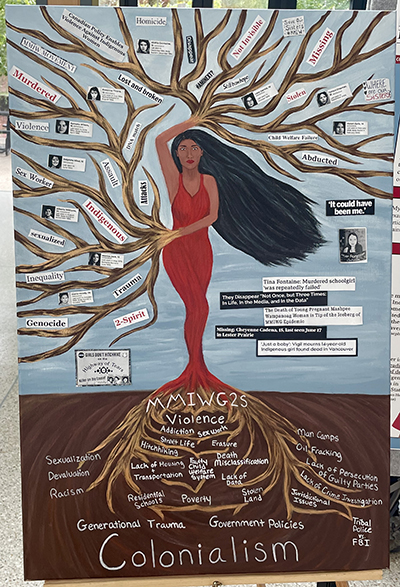
As I took classes at Bridgewater and met incredible English professors, that gave me an idea of the direction I wanted to go and made me realize my passion for research.
Sunnie Souza, ’23, was undaunted, being the only student on a panel of professors at a recent Canadian studies conference. Instead, she saw an opportunity to raise awareness about the crisis of missing and murdered Indigenous women.
“Indigenous women experience extraordinarily high levels of violence,” said Souza, who shared her research at last fall’s Middle Atlantic and New England Council for Canadian Studies conference, held in Niagara Falls, Ontario. “I wanted to look into why that is, what is allowing that to continue and become this issue so many people don’t know about that is so prevalent.”
As Bridgewater State University celebrates the 50th anniversary of its Canadian Studies program, research like Souza’s will take center stage at a special on-campus conference March 31. The oldest of several interdisciplinary global programs, Canadian Studies includes a minor and courses across the university. It brings visiting scholars to campus and supports student and faculty research.
Souza came to BSU unsure what to pursue besides her love of writing.
“As I took classes at Bridgewater and met incredible English professors, that gave me an idea of the direction I wanted to go and made me realize my passion for research,” said Souza, an English major who minored in Native American and Indigenous studies and finished her degree requirements in December.
With guidance from her mentor, English professor Joyce Rain Anderson, Souza perused databases and investigated causes of the crisis in which Indigenous women who live in Canada are 12 times more likely to be murdered or go missing than other women. The issue affects Canada and the United States, yet receives little attention from the media and public, especially compared to missing or murdered white women, Souza said.
Anderson was impressed with Souza’s commitment to illuminate the causes of the crisis and embrace an interdisciplinary approach.
“Sunnie was interested in the ways in which art and writing connect to one another,” Anderson said.
Drawing inspiration from Indigenous art advocacy, Souza created a painting showing a woman in a red dress whose limbs form the trunk and branches of a tree. The painting highlights colonialism and other causes of the crisis, as well as the resiliency of Indigenous women.
“I think it can be more effective to provide something visual in addition to the information I’m giving,” she said. “It can provide more of an impact, which is what I wanted.”
She praised Dr. Anderson for recognizing her interest in the subject and providing opportunities for further exploration in class projects. Souza also conducted research with funding from Bridgewater’s Adrian Tinsley Program.
She hopes to make research a central part of her career, a goal she may have never developed if not for Anderson’s mentorship and the opportunities BSU provides.
“I wanted to make an impact, but I wasn’t sure how until I got into research,” she said.
Do you have a BSU story you'd like to share? Email stories@bridgew.edu.
